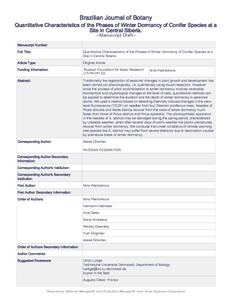Quantitative characteristics of the phases of winter dormancy of conifer species at a site in Central Siberia
Скачать файл:
URI (для ссылок/цитирований):
https://elib.sfu-kras.ru/handle/2311/27886Автор:
Pakharkova, N. V.
Heilmeier, Hermann
Gette, Irina G.
Andreeva, E. B.
Grachev, A. M.
Gaevskiy, N. A.
Grigoriev, Yu. S.
Коллективный автор:
Институт экономики, управления и природопользования
Кафедра экологии и природопользования
Дата:
2016Журнал:
Brazilian Journal of BotanyКвартиль журнала в Web of Science:
Q3Библиографическое описание:
Pakharkova, N. V. Quantitative characteristics of the phases of winter dormancy of conifer species at a site in Central Siberia [Текст] / N. V. Pakharkova, Hermann Heilmeier, Irina G. Gette, E. B. Andreeva, A. M. Grachev, N. A. Gaevskiy, Yu. S. Grigoriev // Brazilian Journal of Botany. — 2016. — . — .Аннотация:
Traditionally the registration of seasonal changes in plant growth and development has been carried out phenologically, i.e., qualitatively using visual inspection. However, since the process of plant acclimatization to winter dormancy involves reversible biochemical and physiological changes at the level of cells, quantitative methods can be applied to determine the duration and the depth of winter dormancy in perennial plants. We used a method based on detecting thermally induced changes in the zero-level fluorescence (TICZF) on needles from four Siberian coniferous trees. Needles of Picea obovata Ledeb. and Abies sibirica Ledeb. recover from the state of winter dormancy much faster than those of Pinus sibirica Du Tour and Pinus sylvestris L. The photosynthetic apparatus in the needles of A. sibirica may be damaged during the spring period, characterized by unstable weather, when after several days of warm weather, the plants prematurely recover from winter dormancy. We conclude that under conditions of climate warming tree, species like A. sibirica may suffer from severe diebacks due to desiccation caused by premature break of winter dormancy.

